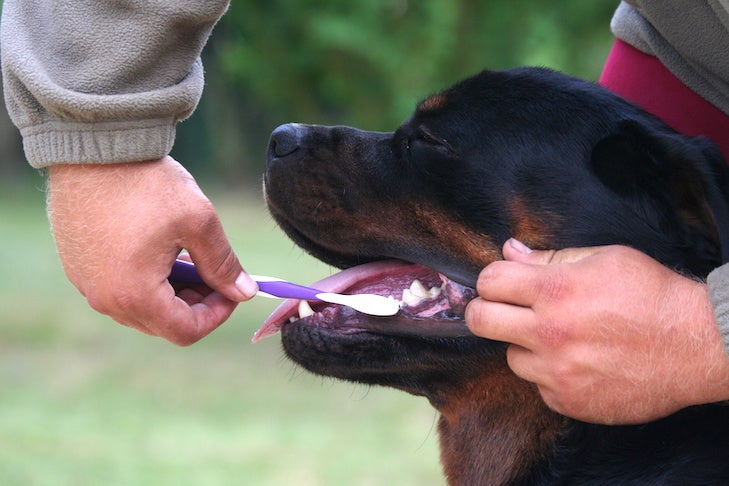AKC is a participant in affiliate advertising programs designed to provide a means for sites to earn advertising fees by advertising and linking to akc.org. If you purchase a product through this article, we may receive a portion of the sale.
Paid Advertisement
You may have heard that dog dental care is unnecessary because chewing toys or munching on kibble cleans dogs’ teeth. In fact, like people, dogs need regular dental care, and they can suffer from periodontal disease, oral pain, tooth loss, and injured teeth.
Beyond pain and discomfort, these dog dental problems can lead to serious health issues that affect other organs, such as the heart, kidneys, and liver. In addition to regular vet visits, you can take important steps at home to prevent dog dental disease. Keeping your dogs’ mouth healthy can also help prevent bacteria from causing tooth decay and gum disease in dogs.
Get to Know the Inside of Your Dog’s Mouth
Whether the newest addition to your home is a puppy or a senior dog, it’s essential to develop a dental care routine. A good place to start is by learning how many teeth your dog has. By the time your puppy turns 5 or 6 weeks old, they will usually have their full complement of deciduous teeth (also known as primary or baby teeth). Usually, dogs have 28 total baby teeth, though some may have fewer. These sharp, pointy teeth help your puppy chew solid food as the muscles in their jaw get stronger.
Primary teeth tend to fall out by the time your puppy is 6 months old. At this point, the permanent teeth begin to erupt, resulting in 42 adult teeth. Sometimes dogs will keep their puppy teeth alongside their adult teeth. If puppy teeth are crowding the mouth, your vet may recommend extracting them (a procedure that requires your dog to be sedated).
Dogs have four types of teeth: incisors, canines, premolars, and molars. Incisors and canines help your dog or holding onto something, like a treat or toy. Premolars and molars are for chewing and grinding food.
Healthy gums are firm and pink, sometimes with black spotting. A dog’s breath should have a neutral odor. Their teeth should be an ivory color, although, if plaque and tartar have built up, your dog’s teeth may be darker.

Common Dog Dental Issues
Here are some oral health issues you may see in your dog, and how they can affect your dog’s dental health.
Dog Plaque
Similar to humans, dogs get plaque on their teeth. Dog plaque is a sticky layer of bacteria that forms from saliva and leftover bits of food. Developing plaque is normal and unavoidable, but it’s still important to remove dog plaque. Without regular brushing and dental cleanings, plaque can build up on the enamel of the tooth and harden into what’s called tartar or calculus.
Tartar on Dogs’ Teeth
Tartar is made up of various organic materials, such as bacteria, food particles, and mineral salts. When dog tartar accumulates, it can cause gum inflammation and disease, loose teeth, tooth decay, abscesses (a buildup of pus), and other oral infections. These issues can negatively affect a dog’s overall health. Because dog tartar is soft at first, it’s easier to treat in the early stages, before it hardens and becomes difficult to remove.
Bad Dog Breath
Signs of dog dental disease may include inflamed gums (gingivitis) and bad breath in dogs. It’s good to familiarize yourself with what your dog’s breath smells like normally. This can help you recognize when there’s been a change in their health. Foul, acrid, or sour dog breath could be a sign that something in their mouth requires veterinary attention.
Other signs of dog dental disease include bleeding or inflamed gums, chewing on one side of the mouth, or being reluctant to eat their food. Often, dental issues develop over time, so with regular dental checkups and preventive care, you can intervene early and prevent tooth disease and loss.
Breed Size and Oral Health
Dental problems may be different for large and small dogs. Smaller dogs, especially Toy Group breeds, can be at greater risk for periodontal disease, tartar formation, gum recession, and tooth decay and loss. Like all adult dogs, smaller dogs have 42 teeth, but these need to fit into a tiny space, which can cause dental crowding or teeth growing in at different angles. In contrast, bigger dogs have more room for their teeth.

Large-breed dogs can have dental issues, too. In addition to tartar buildup, large dogs are also at higher risk of fracturing a tooth if they chew aggressively, play games like tug-of-war, or chew on sticks or gnaw on antlers. Tooth fracture in dogs can lead to decay, infection, tooth loss, and disease.
Maintaining Dog Dental Care
Dog Dental Care at Home
It’s important to clean your dog’s teeth at home, but you shouldn’t use the same products you use on your own teeth. Human toothpaste often contains xylitol, a sugar-free sweetener that’s toxic to dogs. If a dog accidentally eats xylitol, they may have low blood sugar, or they can even die.
Fortunately, there are many dog-safe dental care products. Whichever product you decide to use, be sure to consult first with your veterinarian. You can get your dog used to having their teeth brushed at home. Try a dog toothbrush with soft bristles or a silicone brush that fits over your finger. These finger brushes help you avoid pressing too hard while cleaning your dog’s teeth. You’ll also want to use a dog toothpaste that’s specially formulated for dogs and comes in flavors like poultry or beef.
If your dog resists you brushing their teeth, there are alternative dog dental care routines. You can try using dental sprays for dogs, dog dental chews, dental wipes for dogs, and dental supplements for dogs. Your vet may recommend a chlorhexidine rinse or dog dental gel to deals with plaque (although not all dogs enjoy the taste).
How Your Vet Can Provide Dog Dental Care
When you take your dog for a routine checkup, your veterinarian will examine your dog’s teeth and gums. They’ll check to see if there’s a buildup of tartar or any redness, inflammation, or recession of the gums.

As your dog gets older, your vet might recommend a professional dental cleaning, which will require your dog to go under anesthesia. If they spot a tooth that is diseased or fractured, they will likely suggest removing the tooth, which should help with dental discomfort. An infected tooth indicates the presence of bacteria that can spread to other parts of the body and cause illnesses.
Discuss whether your dog’s current diet is complete and nutritionally balanced, which is important for oral health. Aside from nutritious dog food, you can give your dog digestible chews that are the appropriate size. Try to avoid chews that are hard or can fracture teeth or break apart and become a choking hazard. Some soft chews may also add extra calories to your dog’s diet or obstruct your dog’s digestive tract.
PetLab Co. helps give our best friends the richest, healthiest lives possible through the power of scientific nutrition. To date, they’ve impacted the lives of over three million dogs and counting. Their products are vet-reviewed, NASC-approved, and manufactured in the USA in GMP-compliant facilities with global and domestic ingredients. To learn more visit www.thepetlabco.com.
This article is intended solely as general guidance, and does not constitute health or other professional advice. Individual situations and applicable laws vary by jurisdiction, and you are encouraged to obtain appropriate advice from qualified professionals in the applicable jurisdictions. We make no representations or warranties concerning any course of action taken by any person following or otherwise using the information offered or provided in this article, including any such information associated with and provided in connection with third-party products, and we will not be liable for any direct, indirect, consequential, special, exemplary or other damages that may result, including but not limited to economic loss, injury, illness or death.


